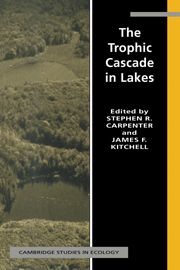Book contents
- Frontmatter
- Contents
- Contributors
- Preface
- 1 Cascading trophic interactions
- 2 Experimental lakes, manipulations and measurements
- 3 Statistical analysis of the ecosystem experiments
- 4 The fish populations
- 5 Fish behavioral and community responses to manipulation
- 6 Roles of fish predation: piscivory and planktivory
- 7 Dynamics of the phantom midge: implications for zooplankton
- 8 Zooplankton community dynamics
- 9 Effects of predators and food supply on diel vertical migration of Daphnia
- 10 Zooplankton biomass and body size
- 11 Phytoplankton community dynamics
- 12 Metalimnetic phytoplankton dynamics
- 13 Primary production and its interactions with nutrients and light transmission
- 14 Heterotrophic microbial processes
- 15 Annual fossil records of food-web manipulation
- 16 Simulation models of the trophic cascade: predictions and evaluations
- 17 Synthesis and new directions
- References
- Index
Preface
Published online by Cambridge University Press: 06 August 2010
- Frontmatter
- Contents
- Contributors
- Preface
- 1 Cascading trophic interactions
- 2 Experimental lakes, manipulations and measurements
- 3 Statistical analysis of the ecosystem experiments
- 4 The fish populations
- 5 Fish behavioral and community responses to manipulation
- 6 Roles of fish predation: piscivory and planktivory
- 7 Dynamics of the phantom midge: implications for zooplankton
- 8 Zooplankton community dynamics
- 9 Effects of predators and food supply on diel vertical migration of Daphnia
- 10 Zooplankton biomass and body size
- 11 Phytoplankton community dynamics
- 12 Metalimnetic phytoplankton dynamics
- 13 Primary production and its interactions with nutrients and light transmission
- 14 Heterotrophic microbial processes
- 15 Annual fossil records of food-web manipulation
- 16 Simulation models of the trophic cascade: predictions and evaluations
- 17 Synthesis and new directions
- References
- Index
Summary
This book attempts a bridge between ecosystem and population ecology. These fields have gradually separated in recent decades as ecosystem science has focused on production and biogeochemical processes at large scales, while population biology has emphasized biotic interactions, often at small scales and typically excluding feedbacks with the physical–chemical environment. The trophic cascade concept has elements of both. It emphasizes the consequences of population interactions for production processes. Population dynamics influence nutrient cycles and must therefore be considered in an ecosystem context. These questions entail concerted work at several different scales, using theoretical principles and practical tools derived from several of the subdisciplines of ecology.
Our approach focused intensive effort on three experimental lakes for seven years. A coordinated, multidisciplinary team is mandatory for this kind of research. We are fortunate to have worked with a remarkable group of collaborators, postdocs, graduate students, technicians, and undergraduates in the course of this project. Their contributions include participation as coauthors of this volume. We also wanted to produce an integrated synthesis of the ecosystem experiments, while minimizing gaps and redundancies that sometimes arise in multiauthored collections. In an attempt to avoid these difficulties, one or both of us is among the authors of most chapters. Our job was made easier by the efforts of Xi He on chapters about fishes and Pat Soranno on chapters about zooplankton.
Individual chapters acknowledge the helpful contributions of reviewers.
- Type
- Chapter
- Information
- The Trophic Cascade in Lakes , pp. xi - xiiPublisher: Cambridge University PressPrint publication year: 1993



